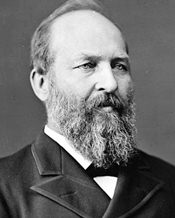The Presidents of the USA



| Born | Nov. 19, 1831, Orange, Ohio |
| Political party | Republican |
| Education | • Williams College, B.A., 1856 |
| Military service | 42nd Ohio Infantry, 1862-63 |
| Previous public office | ♦ Ohio Senate, 1859-61 ♦ House of Representatives, 1863-80 ♦ member of electoral commission, 1876 |
| Died | Sept. 19, 1881, Elberon, N.J. |
Garfield was born on the Ohio frontier. He was a canal sailor, a teacher, and a farmer. After graduating from Williams College, he became a professor of ancient languages and literature at Hiram Eclectic Institute.
Garfield entered Republican politics and was elected to the Ohio legislature. During the Civil War he headed a volunteer company that consisted of many of his former students. He distinguished himself with his bravery at the Battle of Chickamauga, receiving a promotion to major general.
Garfield served as a member of the House of Representatives for 17 years. He was a radical Republican who voted for the impeachment of Andrew Johnson and later was one of the two House Republicans to serve on the electoral commission that decided the disputed election of 1876 in favor of Rutherford B. Hayes.
James Garfield was a true dark horse Presidential candidate, one whose name first emerged at the convention itself. He received not a single vote on the first ballot for the Republican nomination in 1880. At the national convention he headed the faction supporting Secretary of Treasury John Sherman and opposing ex-President Ulysses S. Grant and Senator James G. Blaine. The three-way race deadlocked, and on the 36th ballot Garfield was nominated as a compromise candidate. He defeated the Democratic candidate, Civil War hero General Winfield Scott Hancock, by a tiny popular majority, though his electoral college margin was more substantial.
Garfield and Secretary of State Blaine, leaders of the Half-Breed faction of the Republican party (so called because their opponents thought they were half-Democrat), struggled against Senator Roscoe Conkling and other “Stalwart” Republicans over appointments to positions in his administration. Eventually, Garfield appointed his own man as collector of the Port of New York, scoring a victory.
He also started an investigation of corruption in the post office department, which involved the awarding of certain mail routes to political favorites who then submitted inflated claims for payment.
On July 2, 1881, while standing at a railway station in Washington, D.C., Garfield was shot by Charles Julius Guiteau, who wanted to become an ambassador and had been rebuffed by Blaine. Guiteau, evidently insane, shouted, “I am a Stalwart. Arthur is now President of the United States,” implying that Vice President Chester Arthur would get jobs for the Stalwarts.
For 11 weeks Garfield hung between life and death while the cabinet debated questions about Presidential succession, including whether Arthur should assume office as acting President while Garfield lay ill. Garfield died on September 19 and was succeeded by Arthur; his assassin was found guilty of murder and hanged.
James A. Garfield served the second-shortest term of any President (the shortest was served by William Henry Harrison). In the four months before he was shot, he accomplished next to nothing.
Garfield's main success as President was a controversial resurgence of Presidential authority above Senatorial courtesy in executive appointments.
He proposed substantial civil service reform, eventually passed by Congress in 1883 and signed into law by his successor, Chester A. Arthur, as the Pendleton Civil Service Reform Act.